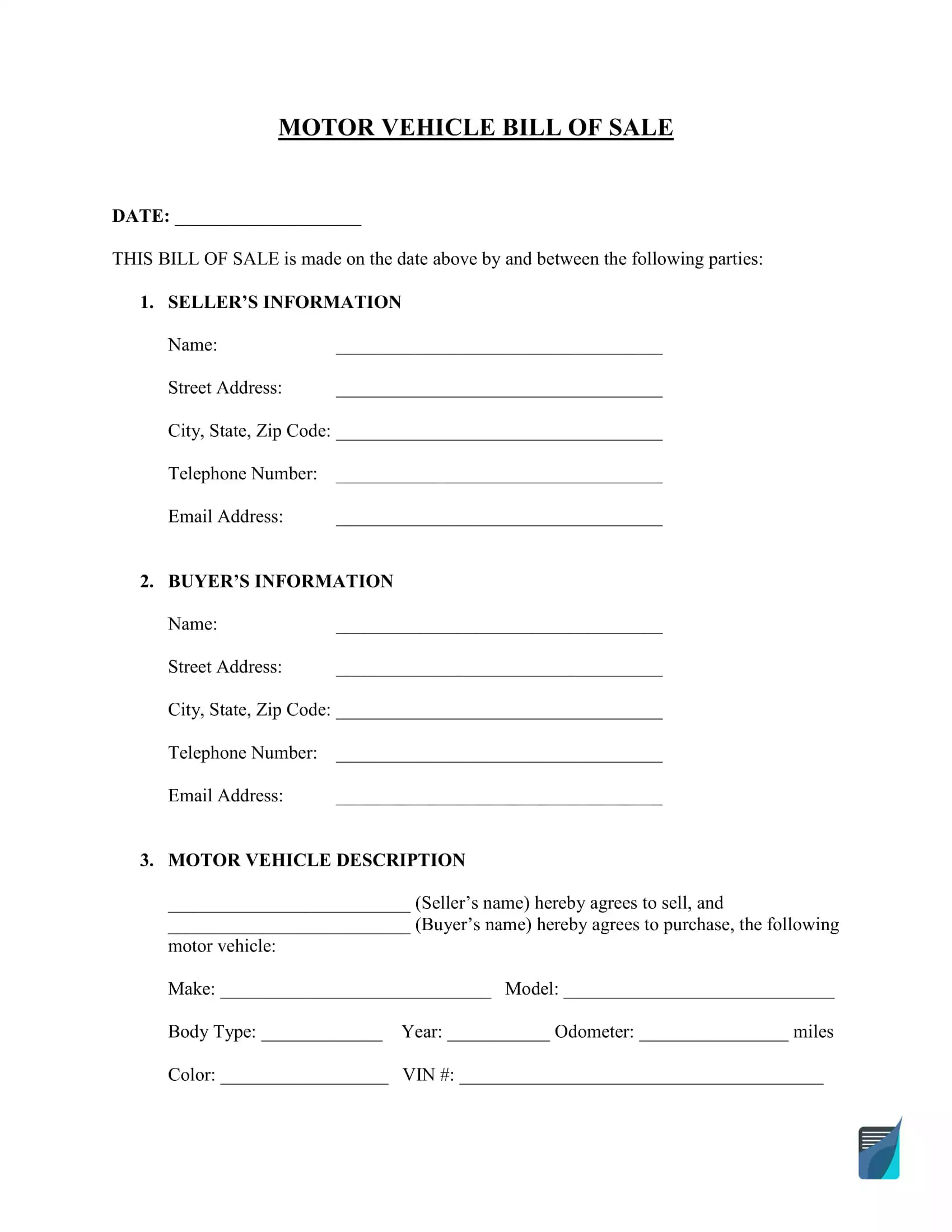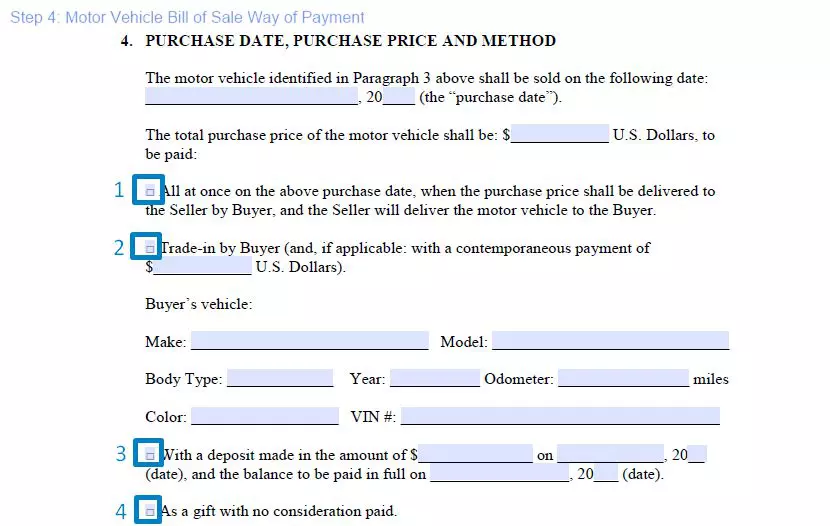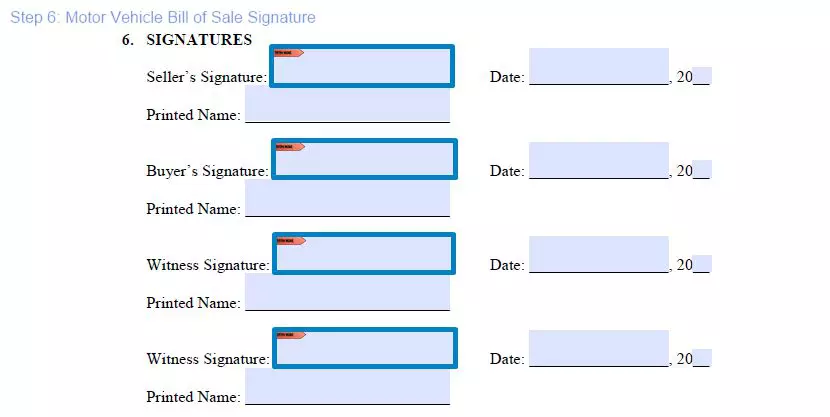Bill of Sale Form for a Car
A bill of sale for car transactions serves as a vital document that records and authenticates the details of a motor vehicle sale. It contains essential information about the transaction, such as the vehicle’s purchase price and VIN.
While this legal document acts as a receipt that confirms and records motor vehicle transactions, it does not provide legal proof of ownership after the transfer. As a result, new owners must obtain a title to demonstrate their ownership of the vehicle. Depending on your state’s DMV regulations, the seller may need to submit a completed bill of sale template before finalizing the title transfer paperwork.

Build Your Document
Answer a few simple questions to make your document in minutes
Save and Print
Save progress and finish on any device, download and print anytime
Sign and Use
Your valid, lawyer-approved document is ready
The requirements for a car bill of sale vary across states. All states require that the document includes the vehicle’s odometer reading. Some ask for signatures from both parties involved in the transaction. Conversely, other states require only the seller’s signature to transfer ownership and establish proof of sale. Regardless of the specific regulations, a bill of sale remains a crucial component in the process of buying or selling a car and its further registration by the buyer.
- Alabama
- Alaska
- Arizona
- Arkansas
- California
- Colorado
- Connecticut
- Delaware
- Florida
- Georgia
- Hawaii
- Idaho
- Illinois
- Indiana
- Iowa
- Kansas
- Kentucky
- Louisiana
- Maine
- Maryland
- Massachusetts
- Michigan
- Minnesota
- Mississippi
- Missouri
- Montana
- Nebraska
- Nevada
- New Hampshire
- New Jersey
- New Mexico
- New York
- North Carolina
- North Dakota
- Ohio
- Oklahoma
- Oregon
- Pennsylvania
- Rhode Island
- South Carolina
- South Dakota
- Tennessee
- Texas
- Utah
- Vermont
- Virginia
- Washington
- West Virginia
- Wisconsin
- Wyoming
- Why is a Bill of Sale Necessary for a Car Sale?
- How to Write a Car Bill of Sale? (Example)
- Step 1: Indicate the bill of sale creation date
- Step 2: Provide buyer and seller information
- Step 3: Include detailed vehicle information
- Step 4: Specify payment details and purchase price
- Specify payment details and purchase price
- Step 5: Review standard provisions and ensure both parties understand them
- Step 6: Sign the bill of sale form
- Step 7: Consider notarizing the form
Why is a Bill of Sale Necessary for a Car Sale?
First, a car bill of sale serves as a receipt that validates the transfer of a vehicle from the seller to the buyer. Although not mandatory in most states, it is advisable for both parties to complete this form during the private transaction of motor vehicles, as it provides protection in the event of potential disputes or complications.
Second, a bill of sale can absolve the seller from any liability if the vehicle is involved in a road accident. Additionally, for the buyer of a used vehicle, a properly executed form offers proof of title transfer, confirming their legal ownership and full rights to the car. Should the vehicle violate any traffic laws, the seller can utilize the bill of sale in legal proceedings to demonstrate that they no longer own the vehicle, thereby avoiding criminal liability.
Third, when completed accurately, a bill of sale form can also function as a loan instrument, similar to a promissory note. For example, if a buyer is purchasing a vehicle in installments, the document can be structured as a bill of sale. However, the transfer of title and possession will only occur after all outstanding payments have been made, ensuring a comprehensive transaction process. As a result, state regulations on car bill of sale requirements help to prevent abuse by either the seller or the buyer.

How to Write a Car Bill of Sale? (Example)
The following guidelines are designed for the template available on our site, which allows you to create your own bill of sale. However, if a document is available from your local authorities, you can also use that for the transaction.
Step 1: Indicate the bill of sale creation date

Step 2: Provide buyer and seller information
- Name
- Street
- City
- State
- Zip code
- Phone number
- Email address

Step 3: Include detailed vehicle information
- Make (manufacturer)
- Vehicle model
- Body style
- Year
- Odometer reading
- Color
- Vehicle Identification Number (VIN)

Step 4: Specify payment details and purchase price
Specify payment details and purchase price
Include the exact purchase date and agreed-upon amount. Indicate the chosen payment method:
- Full payment: The buyer pays the full amount in a single transaction, and the seller transfers the vehicle the same day.
- Trade-in: The buyer trades their used car (with or without additional payment) for the seller’s vehicle. Include the buyer’s vehicle details in the document.
- Installment payments: Specify the down payment amount, due date, and final payment due date.
- Gift with no consideration: The seller gifts the vehicle to the buyer without expecting compensation.
Next, state the payment method:
- Cash
- Cheque
- Cashier’s cheque
- Money order
Finally, indicate whether all applicable sales taxes are included in the final cost.

Step 5: Review standard provisions and ensure both parties understand them
The seller confirms their ownership of the vehicle, their right to sell it, and that there are no liens on it. They also verify that the vehicle information provided is true, accurate, and complete to the best of their knowledge.
The “as-is” clause states that the seller offers no warranties and is not responsible for maintenance after the transfer.

Step 6: Sign the bill of sale form
Though not always required, obtaining the buyer’s signature can offer additional legal protection. Both parties may also choose a witness to attest to the transaction and sign the bill of sale.

Step 7: Consider notarizing the form
While notarization is usually not mandatory, it can provide extra legal security. If you decide to notarize the document, locate a local notary public. Once notarized, the bill of sale offers stronger protection for both the previous and new owner, similar to purchase agreements.
A bill of sale is required for a title change in many states, so the buyer should keep the original. As a seller, you can either retain a copy or have all parties sign and complete two identical forms. Generally, the new owner should register the vehicle at their local DMV or county office.

